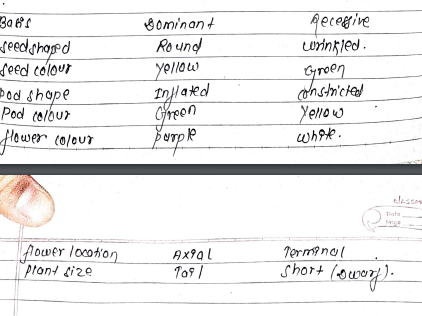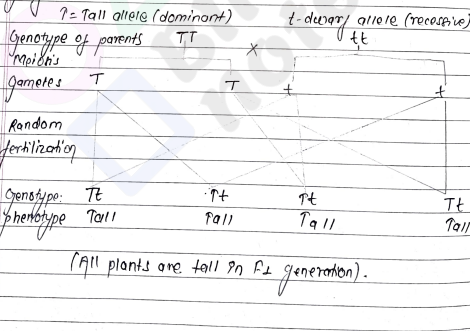Symbol and terminology
The basic terms used in genetic inheritance are described below :-
- 1. Genes
-
A gene is the shortest segment of DNA. A gene is also called the basic unit of heredity. Gene are arranged on chromosomes.
- 2. Genome
-
It is the total genetic of an organism.
- 3. Allele or allelomorph
-
An allele is one of a particular form of gene. Allele is the short form of allelomorph. It is an alternate form of the same gene in which one is the parental and another is maternal. For example, T and t are two allelomorphs of the gene for height of the plant.
- 4. Locus
-
The point on a chromosome where an allele is located called locus.(loci=plural)
- 5. Homozygous
-
A diploid individual carrying two identical (similar) alleles is known as homozygous. It is pure or traits. The upper TT and tt are two identical alleles for tallness and dwarfness respectively.
- 6. Heterozygous
-
A diploid individual carrying two different alleles is known as heterozygous or hybrid.
- 7. Dominant allele
-
Out of two alleles, the one that is capable of expressing itself by holding or suppressing its contrasting allele is known as dominant allele.
- 8. Recessive allele
-
Out of the two alleles, the one which is being supposed by its alternative allele is called the recessive allele. Recessive allele doesn't express itself when present with the dominant allele (in heterozygous form).
- 9. Genotype
-
A genotype is the genetic expression of on organism. It is the genetic constitution of an organism. For plant heigho TT, Tt and tt are different genotype..
- 10. Phenotype
-
It is the physical or the observable expression of an organism.
- 11. Character
-
It refers to a general feature of an organism such as eye colour, plant height etc.
- 12. Parental generation
-
The plants used as parents in a cross are said to represent parental generation designated by 'P'
- 13. Hybrid
-
It is the product of a cross in between the two dissimilar parents having contrasting characters.
- 14. Monohybride cross
-
A cross between the two parents that differ in one pair of alternating (contrasting) characters is called Monohybride cross.
- 15. Dihybrid cross
-
A cross between the two parents that differ in two pairs of alternating characters is called dihybrid cross. For example seed shape and seed color (round yellow vesus wrinkled green).
- 16. Filial (F) generation
- The progeny obtained as a result of crossing between parts is a hybrid progency and is called filial generation. It is represented by F1 and F2.
- 17. Pure line
-
It is the variety (ine) which maybe hemozygous or heterozygous in condition.It is the parental lines. It is called the true breeding varieties.
- 18. Backcross
-
A cross that involves crossing of of F1 hybrid with one of its parents (P1 or P2) is known as Back Cross.
- 19. Test cross
-
In this cross the individual of an unknown genotype is crossed with homozygonous respective parents. This cross is made in order to determine the the genotype of the unknown Individual.
- 20.Pedigree
-
The history of the descent of a person or family.
- 21. Reciprocal cross
-
It is the cross of the same genotype where gametes from the parental generation are reversed. In experiment if "A" is used as the female parent and "B" as the male parent in one experiment and in other experiment "A" and "B" are used opposite of 1st experiment. The purpose of reciprocal cross is to find out whether both parents are making equal contribution or not.
- 22. Punnett square
-
It is a checker bond or graphic method to study all possible result of various crosses.It was discoverd by a geneticist R.C punnett(1906).Pannett of square is helpful to understand various probability of combinations as well as to find their probability if occurance in a genesation.

